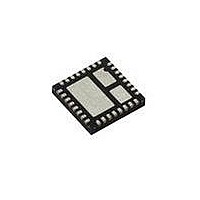SIC417CD-T1-E3 Vishay, SIC417CD-T1-E3 Datasheet - Page 7

SIC417CD-T1-E3
Manufacturer Part Number
SIC417CD-T1-E3
Description
IC DRIVER MOSF SYNC BUCK 55MLPQ
Manufacturer
Vishay
Series
microBUCK™r
Datasheet
1.SIC417CD-T1-E3.pdf
(20 pages)
Specifications of SIC417CD-T1-E3
Topology
Step-Down (Buck) Synchronous (1), Linear (LDO) (1)
Function
Any Function
Number Of Outputs
2
Frequency - Switching
200kHz ~ 1MHz
Voltage/current - Output 1
0.5 V ~ 5.5 V, 10A
Voltage/current - Output 2
0.75 V ~ 5.25 V, 150mA
W/led Driver
No
W/supervisor
No
W/sequencer
No
Voltage - Supply
3 V ~ 28 V
Operating Temperature
-25°C ~ 125°C
Mounting Type
*
Package / Case
*
Output Voltage
0.5 V to 5.5 V
Output Current
10 A
Input Voltage
3 V to 28 V
Switching Frequency
200 KHz to 1 MHz
Mounting Style
SMD/SMT
Duty Cycle (max)
95 %
Primary Input Voltage
28V
No. Of Outputs
1
Voltage Regulator Case Style
MLPQ
No. Of Pins
32
Operating Temperature Range
-25°C To +125°C
Svhc
No SVHC
Rohs Compliant
Yes
Lead Free Status / RoHS Status
Lead free / RoHS Compliant
Lead Free Status / RoHS Status
Lead free / RoHS Compliant, Lead free / RoHS Compliant
Available stocks
Company
Part Number
Manufacturer
Quantity
Price
Part Number:
SIC417CD-T1-E3
Manufacturer:
VISHAY/威世
Quantity:
20 000
ELECTRICAL CHARACTERISTICS
APPLICATIONS INFORMATION
SiC417 Synchronous Buck Converter
The SiC417 is a step down synchronous buck dc-to-dc
converter with integrated power FETs and programmable
LDO. The SiC417 is capable of 10 A operation at very high
efficiency in a tiny 5 mm x 5 mm - 32 pin package. The
programmable operating frequency range of 200 kHz to
1 MHz, enables the user to optimize the solution for minimum
board space and optimum efficiency.
The buck controller employs pseudo-fixed frequency
adaptive on-time control. This control scheme allows fast
transient response thereby lowering the size of the power
components used in the system.
Input Voltage Range
The SiC417 requires two input supplies for normal operation:
V
28 V. V5V requires a 5 V supply input that can be an external
source or the internal LDO configured to supply 5 V. When
V
tied to V5V.
Pseudo-Fixed Frequency Adaptive On-Time Control
The PWM control method used for the SiC417 is
pseudo-fixed frequency, adaptive on-time, as shown in
figure 1. The ripple voltage generated at the output capacitor
ESR is used as a PWM ramp signal. This ripple is used to
trigger the on-time of the controller.
The adaptive on-time is determined by an internal oneshot
timer. When the one-shot is triggered by the output ripple, the
device sends a single on-time pulse to the highside
MOSFET. The pulse period is determined by V
the period is proportional to output voltage and inversely
proportional to input voltage. With this adaptive on-time
arrangement, the device automatically anticipates the
on-time needed to regulate V
condition and at the selected frequency.
Document Number: 69062
S10-1367-Rev. D, 14-Jun-10
IN
IN
and V5V. V
is less than ~ 6 V then an external 5 V supply must be
Over Current Protection: V
IN
operates over the wide range from 3 V to
IN
OUT
= 12 V, V
for the present V
OUT
= 1.2 V
OUT
and V
IN
IN
;
The adaptive on-time control has significant advantages over
traditional control methods used in the controllers today.
• Reduced component count by eliminating DCR sense or
• Reduced
• Ultra fast transient response because of fast loop,
• Predictable frequency spread because of constant on-time
• Fast transient response enables operation with minimum
Overall, superior performance compared to fixed frequency
architectures.
Q2
Q1
current sense resistor as no need of a sensing inductor
current.
compensation by eliminating the no error amplifier and
other components.
absence of error amplifier speeds up the transient
response.
architecture.
output capacitance
V
IN
Figure 1 - Output Ripple and PWM Control Method
V
Ultra-Sonic Power-Save at I
LX
Saves
C
IN
L
external
t
ON
+
ESR
V
FB
C
components
OUT
Vishay Siliconix
V
LX
OUT
= 0 A
FB threshold
www.vishay.com
SiC417
used
FB
V
OUT
for
7












